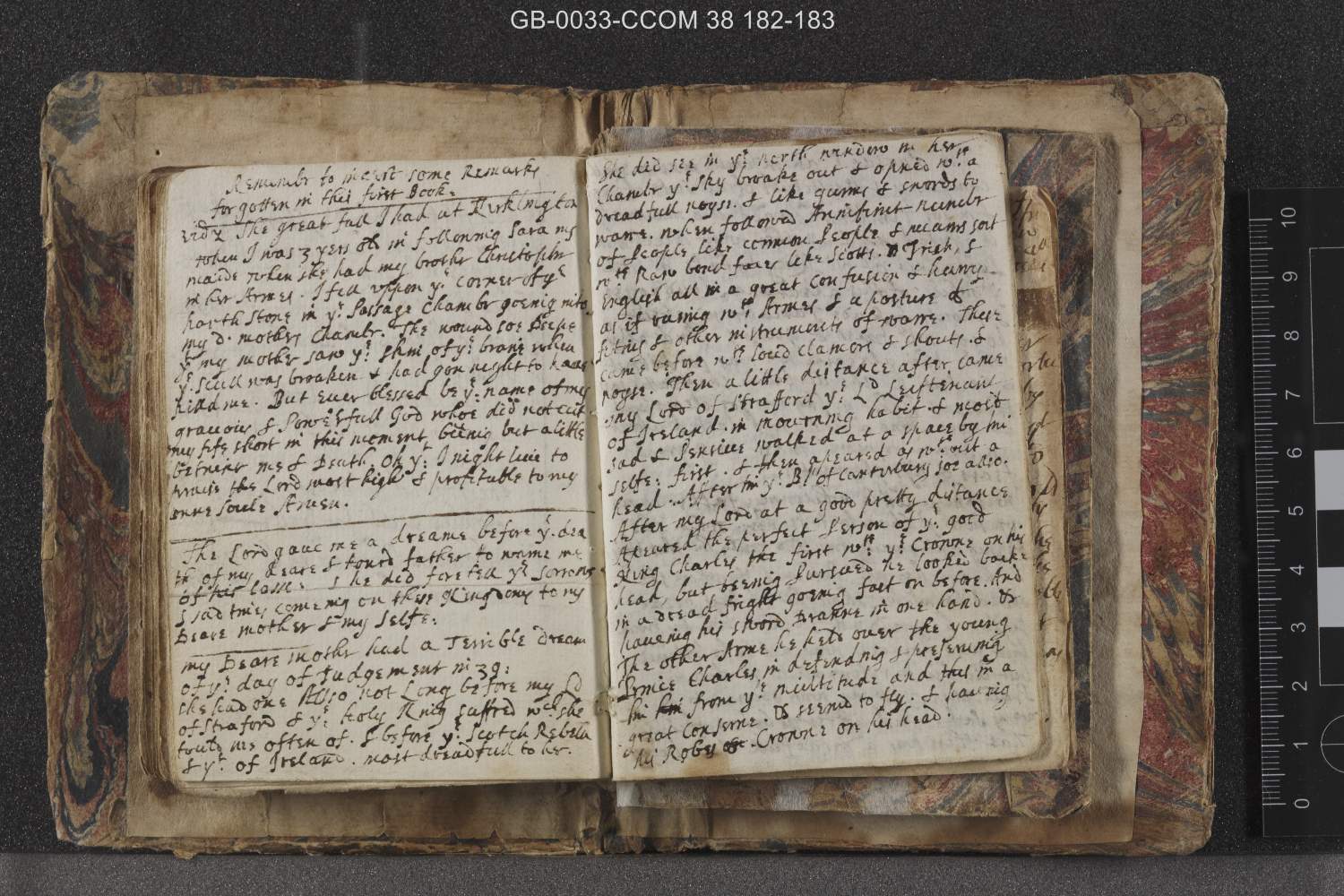[ad_1]
Led by Professor Cordelia Beattie of The University of Edinburgh, the project follows her discovery of a previously lost version of Thornton’s autobiography, written between 1659 and 1673.
Alice Thornton wrote four versions of her autobiography which offer insight into life as a royalist, Church of England woman during the:
- Irish Rebellion of 1641
- English Civil War
- Restoration era
In contrast to Samuel Pepys who wrote his diaries during the same period, she gives a northern, female perspective on contemporary events.
A unique insight
Alice Thornton’s Book 2: The First Book of My Widowed Condition. Reproduced by kind permission of the Chapter of Durham Cathedral. Credit: Durham Cathedral Library, GB-0033-CCOM 7
The manuscripts chronicle Thornton’s life, including her childhood in Ireland and return to England during the civil war.
They also documented her experiences as a wife, mother and widow as she faced scandal and financial ruin.
She married into a parliamentarian family in 1651 to help secure her family’s estate after the death of her older brother.
However, her husband made a series of financial errors, which meant when he died he left her saddled with debts.
A dramatic life
All of the books address dramatic moments in Alice Thornton’s life.
For instance, book three was written in the aftermath of the death of her son.
This event triggered the passing of her estate of East Newton into the hands of her son-in-law, Thomas Comber, the earlier subject of a scandal.
17th century scandals
Thornton wrote in book three, on page 96:
he should be so deeply concerned for my injuries and wrongs by that slanderous tongue, of Mr Tancred of Arden (who had laid a wager with my dear Lady Yorke of £100 that if my husband were dead, I would be married within a month to Mr Comber) which lie did so concern my dear husband that he told my aunt Norton he would be revenged of that traitor for traducing so much his chaste and innocent wife with such a false lie; for he knew that we designed it a match with his daughter, Alice.
The early modern woman writer
Thornton’s books offer an extraordinarily rich example of how a woman below the ranks of the nobility wrote about her life in early modern England and Ireland.
The fact that she produced more than one version of it makes her even more exceptional.
Although it has long been established that many male diarists such as Pepys curated their texts, we now have evidence of that for an early modern woman writer.
A deliberate retelling of events
Professor Beattie, said:
To misquote Oscar Wilde, to find one missing manuscript was good fortune, to find two was career changing.
Our work with the manuscripts has led us to conclude that two of the four were written much later in life than the events described and constitute a deliberate retelling of events for the benefit of her descendants.
Thornton was particularly keen to restate her identity as a chaste wife and to lay the blame for the family’s downturn in fortune on various male family members, including her late husband.
Thornton’s writings show that, alongside domestic and familial responsibilities, early modern women were fully engaged with the political events of their day.
As she writes to persuade readers of the justice of her cause, Thornton’s Books complicate any sense that writing in manuscript was a private activity.
One of the audience members for a play based on this text summed up Alice Thornton’s life as ‘17th century Eastenders’ which shows that the themes explored in these manuscripts are still relevant, important and engrossing.
Connecting us with heritage and history
Professor Christopher Smith, Executive Chair, Arts and Humanities Research Council (AHRC), which funded the research, said:
We are delighted that AHRC funding has facilitated the discovery and study of Alice Thornton’s extraordinary life and writing.
Thornton’s writings provide evidence that early modern women were not only active participants in their local communities but fully engaged with the national and international events of their day.
The recovered manuscript reveals her to be financially savvy and involved in negotiating complex legal matters.
This is a great example of how research in arts and humanities disciplines connects us with our own heritage and cultural history and offers fascinating insights into our shared past.
The four books of Thornton’s life
The four versions of her autobiography all treat the period of Thornton’s life from birth in 1626 to her first year of widowhood in 1669.
While a 19th century edition made a single account in chronological order, this doesn’t accurately reflect the content of her manuscripts, which were written at different times, for different reasons.
Book one
In book one, Alice Thornton defends herself in 1668 as rumours were circulating about an extra-marital affair with the local curate, Thomas Comber, who was engaged to her 14-year-old daughter.
Book two
The Durham manuscript was written in a later period where Thornton and her son were heavily in debt, and once again she writes to defend herself.
This time, she defends herself to her descendants of any claims of financial mismanagement, which she blames on other family members.
Book three
Book three was written in the aftermath of the death of her son in 1692.
This event triggered the passing of the Thornton estate of East Newton into the hands of her son-in-law, Thomas Comber, the subject of the earlier scandal.
The Book of Remembrances
The Book of Remembrances, also located by Professor Beattie, was likely written first and used as a draft for book one.
It records births, marriages and deaths briefly, until the death of her mother in 1659, which leads to more detailed entries.
Based at The University of Edinburgh’s School of History, Classics and Archaeology, Professor Beattie’s research team has produced a searchable digital edition of Alice Thornton’s books.
[ad_2]
Source link



